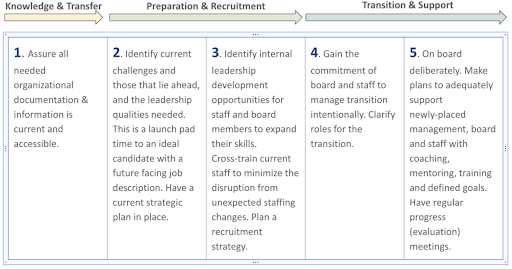Succession Planning isn’t a “thing” that comes out of nowhere. It’s a natural progression in all organizations. Folks retire, change jobs, and leave for a whole bunch of reasons. That’s a fact of life. You can be shocked when it happens and go into panic mode, or you can plan for it.
Whether for board members, ED’s, CEO’s, or staff, when Succession Planning is done as a thoughtful, planned process, the outcomes and the transitions are much smoother. Momentum is not as compromised.
I wish there was some magic to this, but I haven’t found it. I’ve only affirmed we need preparation, thoughtful planning, engagement of the affected stakeholders, and the willingness to make this a strategic priority. As a matter of fact, this inevitable event needs to be a part of your strategic planning so it stays on your radar.
Here are a few guidelines to consider.
Succession Planning includes:
- Knowledge & Knowledge Transfer
- Preparation & Recruitment
- Transition & Support
These five elements form the framework you’ll need:
I’d recommend that a Succession Planning Committee be set up to get the ball rolling. With the committee’s direction, a workable plan can be put into place. Then as necessary, you can adapt the basic plan to deal with the succession needs at hand.
In a recent discussion I had during a workshop I facilitated for 2021 Housing Central, BC’s Affordable Housing Conference, a participant wisely suggested a workplace and board of directors’ culture of ‘no surprises’ was critical for effective succession planning. If transparency was accepted as the norm for communication within the organization, then the ‘perceived’ difficult topic of succession would not be threatening, but rather a welcome confirmation that people do move on from organizations, and it’s not something to be feared or hidden!
I do hope you find this helpful, and you won’t be surprised when someone is ready to move on from your organization.
Frank




